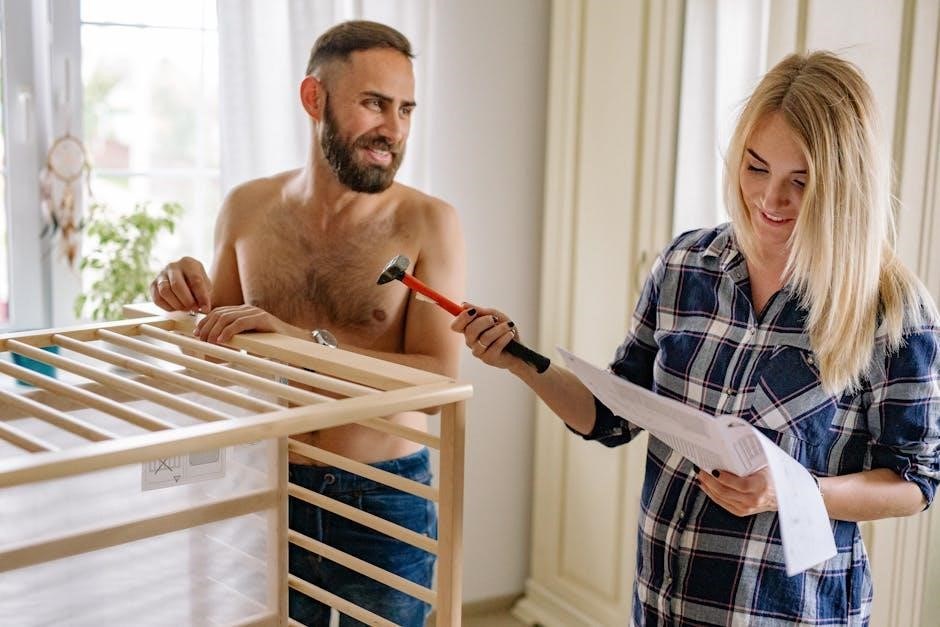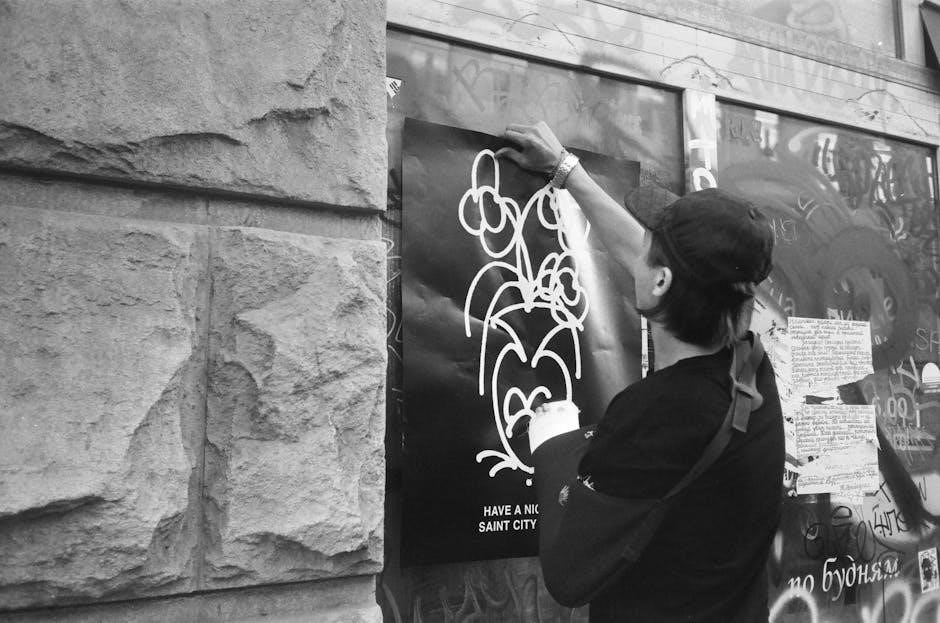The Donjoy Sling provides essential immobilization and support for upper limb injuries or post-surgery recovery, designed to ensure proper healing by minimizing movement and promoting stability and comfort.
What is a Donjoy Sling?
A Donjoy Sling is a medical device designed to provide immobilization and support for the upper limb, particularly after injuries, surgeries, or conditions affecting the shoulder or arm. It consists of a padded arm sleeve, adjustable straps, and an abduction pillow to maintain proper alignment and reduce movement. The sling is engineered to protect the shoulder joint, enabling optimal healing while minimizing discomfort. Its adjustable design ensures a customizable fit for various body types and recovery needs, making it a versatile tool for post-surgical rehabilitation or managing injuries requiring immobilization.
Importance of Proper Sling Usage
Proper use of the Donjoy Sling is crucial for effective recovery and immobilization of the upper limb. It ensures minimal movement of the injured or surgical site, promoting optimal healing and preventing further injury. Incorrect usage can lead to prolonged recovery or complications. Following the manufacturer’s guidelines ensures the sling functions as intended, providing the necessary support and stability. Proper fitting and adjustment are essential to avoid discomfort or restricted circulation. Adhering to the instructions helps patients achieve the best outcomes during their rehabilitation process.
Overview of Donjoy Sling Models
The Donjoy Sling range offers various models tailored to specific needs, ensuring optimal support and immobilization. The Donjoy Ultra Sling IV features an abduction pillow for post-surgery recovery, while the Donjoy Sling with Abduction Pillow provides enhanced stability for shoulder injuries. The Donjoy UltraSling PRO is designed for versatility, catering to both surgical and non-surgical cases. Each model is crafted with durable materials, adjustable straps, and ergonomic designs to accommodate different body types and injury requirements. These slings are widely used in medical settings and recommended for their reliability and comfort during recovery.

When to Use a Donjoy Sling
A Donjoy Sling is used for shoulder injuries, post-surgery recovery, or temporary immobilization needs, providing necessary support and stability for proper healing.
Medical Conditions Requiring a Sling
A Donjoy Sling is essential for immobilizing the shoulder and arm in cases of dislocations, fractures, or severe sprains. It provides stability for rotator cuff injuries and post-operative recovery. The sling is also recommended for patients with shoulder instability or those requiring post-traumatic immobilization. Additionally, it supports the arm during rehabilitation after shoulder surgery, such as joint replacements or ligament repairs. The sling helps reduce pain and swelling by limiting movement, ensuring proper alignment and promoting healing. It is a vital tool for managing upper limb injuries and conditions requiring immobilization to restore strength and mobility effectively.
Post-Surgery Rehabilitation
The Donjoy Sling is a critical tool for post-surgery rehabilitation, particularly after shoulder surgeries like rotator cuff repairs or joint replacements. It provides immobilization, reducing movement to promote healing and minimize discomfort. The sling’s design, including the abduction pillow, keeps the arm in a neutral position, fostering proper tissue repair. Adjustable straps ensure a secure and comfortable fit, while the breathable materials help prevent irritation. Proper use of the Donjoy Sling during recovery helps restore strength and mobility, ensuring a safe and effective return to normal activities. Always follow the manufacturer’s guidelines for optimal results.
Temporary Immobilization Needs
The Donjoy Sling is ideal for temporary immobilization needs, such as acute injuries, fractures, or soft tissue sprains requiring rest. It provides stability and protection, limiting arm movement to aid recovery. The sling’s adjustable design ensures a secure fit, while the abduction pillow maintains proper arm positioning. This temporary support is essential for reducing pain and preventing further injury during the healing process. Its lightweight and breathable materials enhance comfort, making it suitable for short-term use. Whether for minor injuries or post-trauma care, the Donjoy Sling offers reliable immobilization to support recovery and restore function.

Key Components of a Donjoy Sling
The Donjoy Sling features an arm envelope, forearm and thumb straps, an abduction pillow, and adjustable straps with buckles, ensuring proper immobilization, comfort, and customization for optimal support.
Arm Sling Envelope
The arm sling envelope is a crucial component of the Donjoy Sling, designed to cradle and immobilize the forearm and hand. It is typically made of durable, breathable materials for comfort and support. The envelope is contoured to fit the natural shape of the arm, ensuring proper alignment and reducing strain on the injured area. Adjustable quick-release buckles allow for customization of fit, while the padded interior provides additional comfort. Proper placement of the forearm within the envelope is essential to maintain immobilization and promote healing. The envelope can be adjusted in size by folding or unbuckling straps to accommodate different arm sizes, ensuring a secure and comfortable fit for various users.
Forearm and Thumb Straps
The forearm and thumb straps are essential for securing the arm in the correct position within the Donjoy Sling. These straps ensure proper immobilization by preventing unwanted movement of the forearm and thumb, which is critical for healing. The forearm strap is typically adjustable, allowing for a customized fit to accommodate different arm sizes. The thumb strap provides additional stability, keeping the thumb in a neutral position to avoid strain on the wrist and hand. Both straps are designed with durable, easy-to-use buckles or Velcro closures for quick and secure fastening. Proper tightening of these straps is vital to ensure comfort and effective support during recovery.
Abduction Pillow
The abduction pillow in the Donjoy Sling is designed to maintain the arm in a neutral or slightly abducted position, preventing excessive movement that could disrupt healing. This cushioned pillow supports the arm away from the body, reducing strain on the shoulder joint. Its contoured shape ensures comfort while immobilizing the arm effectively. The abduction pillow is particularly crucial for post-surgical recovery, as it helps maintain proper alignment and prevents complications. It is typically adjustable, allowing for customization to fit individual needs. Proper positioning of the abduction pillow is essential to ensure optimal support and comfort during the recovery process.
Adjustable Straps and Buckles
The Donjoy Sling features adjustable straps and buckles designed to provide a secure and customizable fit. These components allow users to tighten or loosen the sling as needed, ensuring proper immobilization and comfort. The swivel D-ring strap and quick-release buckles enable easy adjustments without compromising support. The straps are made of durable materials to withstand regular use, while the buckles ensure a snug and stable fit. Proper adjustment of these straps is crucial to achieve optimal support and prevent discomfort. They play a key role in maintaining the sling’s effectiveness during recovery or immobilization, making them an essential feature of the Donjoy Sling system.

Application Instructions
Donjoy Sling application involves placing the forearm into the arm envelope, securing straps, and adjusting for proper support and immobilization to ensure a comfortable fit during recovery.
Step 1: Prepare the Sling
Begin by ensuring all straps and buckles are fully extended and unfastened. Remove any optional components, such as the forearm and thumb straps, from the arm envelope and set them aside. Position the abduction pillow at waist level to align with the affected shoulder. Adjust the pillow’s height to match the natural contour of your body. Gently unfold the arm sling envelope, smoothing out any wrinkles to ensure proper fitting. Make sure all tabs and straps are accessible for easy securing later. This preparation ensures a smooth and efficient application process.
Step 2: Put on the Sling
Slide your unaffected side into the sling first, ensuring the arm envelope aligns with your body. Gently place your injured arm into the envelope, resting your forearm on the cushioned support. Position your hand slightly above the thumb strap for proper alignment. Adjust the abduction pillow to maintain your shoulder in the correct position, preventing rotation or strain. Ensure the sling’s edges are not bunched or twisted, providing even support. Once your arm is comfortably placed, proceed to secure the straps to maintain stability and immobilization.
Step 3: Secure the Forearm Strap
After placing your arm in the sling, locate the forearm strap. Bring it across your forearm, ensuring it aligns with the designated fastening points on the sling. Tighten the strap gently but firmly to secure your forearm in place, avoiding excessive pressure that could restrict circulation. Adjust the strap so it sits snugly against your skin, maintaining proper alignment with the arm envelope. Ensure the strap is neither too loose nor too tight, providing optimal support and immobilization for your injury or post-surgical recovery.
Step 4: Fasten the Thumb Strap
Next, locate the thumb strap, typically attached near the forearm strap. Loop the strap around your thumb, ensuring it rests comfortably without causing pressure. Bring the strap across the back of your hand and secure it to the designated buckle or Velcro closure on the sling. Adjust the strap tension to hold your thumb in a neutral position, preventing excessive movement while allowing some flexibility. Ensure the strap is snug but not overly tight, as this could restrict blood flow or cause discomfort. Properly securing the thumb strap is crucial for maintaining optimal immobilization and support for your injury or post-surgical recovery.
Step 5: Adjust for Comfort
After securing the thumb strap, fine-tune the sling for optimal comfort. Ensure the shoulder ring is snug but not constricting, allowing natural arm movement. Tug gently on the swivel D-Ring strap to verify stability. Check that the forearm strap supports your arm without causing pressure points. Adjust the abduction pillow height to maintain your arm in a neutral position, slightly away from your body. Ensure the overall fit is balanced, avoiding any tightness that could restrict blood flow. Make sure the sling fabric is smooth against your skin to prevent chafing. Finally, confirm that your hand remains elevated and your arm is immobilized properly for healing. Regular adjustments may be needed throughout the day for sustained comfort and support.

Fitting and Adjustment
Proper fitting ensures optimal support and comfort. Measure accurately, adjust shoulder ring and straps to achieve a snug yet comfortable fit, promoting healing and stability.
Measuring for Proper Fit
Accurate measurement is crucial for optimal support and comfort. Measure the circumference of the arm at the midpoint between the elbow and shoulder. Ensure the sling fits snugly without restricting circulation. For S/M sizes, unbuckle the quick-release buckles and fold the arm envelope inward, securing the hook and loop tabs. Adjust the shoulder ring to align with the body’s natural contours. Proper fit ensures the forearm strap sits 1-2 inches above the wrist crease, and the thumb strap rests lightly on the thenar eminence. Correct sizing prevents chafing and ensures immobilization, promoting healing and comfort during recovery.
Adjusting the Shoulder Ring
Proper adjustment of the shoulder ring ensures a comfortable and secure fit. To adjust, align the shoulder ring with the natural contour of your body. The ring should be snug but not overly tight, allowing for normal breathing and movement. Use the adjustable straps to fine-tune the fit, ensuring the sling remains balanced. If the ring feels too loose, tighten the straps gradually until support is achieved. Avoid over-tightening, as this may cause discomfort or restrict circulation. Correct alignment and tension ensure optimal immobilization and promote proper healing.
Tightening the Swivel D-Ring Strap
To ensure optimal support, tighten the swivel D-ring strap carefully. Locate the strap near the shoulder ring and gently pull it through the D-ring until it fits snugly. Avoid over-tightening, as this may cause discomfort or restrict movement. Check the alignment to ensure the sling remains balanced and evenly distributed across your body. Proper tension ensures immobilization and stability, promoting healing and comfort during recovery. Adjust as needed to maintain a secure fit without compromising circulation or mobility.
Final Checks for Stability
After adjusting all straps, perform a final check to ensure the Donjoy Sling provides optimal stability. Verify that the arm remains securely positioned in the envelope, with the forearm and thumb straps snug but not restrictive. Check that the abduction pillow supports the shoulder correctly, maintaining proper alignment. Ensure the swivel D-ring strap is tightened evenly and the shoulder ring sits comfortably without slipping. Test the sling by gently moving your arm to confirm it remains stable and does not shift excessively. Make any necessary adjustments to achieve a balanced, secure fit that promotes healing and prevents discomfort.

Care and Maintenance
Regularly clean the sling with mild soap, store it in a dry place, and replace it if damaged or worn out to maintain hygiene and durability.
Cleaning the Sling
Regular cleaning ensures the longevity and hygiene of your Donjoy Sling. Gently hand wash the sling with mild soap and lukewarm water, avoiding harsh chemicals. Use a soft cloth to wipe down straps and padding, paying attention to high-contact areas like the arm envelope and buckles. Rinse thoroughly to remove soap residue. Allow the sling to air dry completely, away from direct sunlight or heat, to prevent damage to the materials. Avoid machine washing or bleaching, as this may compromise the structural integrity or comfort of the sling. Proper cleaning maintains both functionality and patient comfort.
Storing the Sling
Proper storage of your Donjoy Sling ensures its longevity and maintains its structural integrity. After cleaning, allow the sling to air dry completely before storing. Place it in a cool, dry environment, away from direct sunlight to prevent fading or material degradation. Avoid folding or creasing the sling excessively, as this may cause permanent damage. Store it in its original packaging if available, or lay it flat to maintain its shape. Do not compress the sling in tight spaces, as this could alter its form. Regular inspection before and after storage is recommended to ensure no damage or wear has occurred.
When to Replace the Sling
The Donjoy Sling should be replaced if it shows signs of wear, such as frayed straps, cracks in the buckle, or irreversible soiling. If the sling no longer provides adequate support or immobilization, it is time to replace it. Additionally, if the sling has been altered or damaged in a way that compromises its structural integrity, a new one should be obtained. Replace the sling if it no longer fits properly or if it has been used beyond its recommended lifespan. Consult a healthcare professional if you are unsure whether your sling needs replacement to ensure optimal recovery and support.
Troubleshooting Common Issues
Address common issues like strap malfunctions, discomfort, or loss of support to ensure proper use and comfort of your Donjoy Sling.
Strap Malfunction
A strap malfunction can occur due to improper adjustment, excessive wear, or accidental damage. If a strap becomes loose or detached, immediately stop using the sling and inspect for damage. Check buckles and straps for signs of wear or breakage. For minor issues, tighten or reposition the straps. If a strap is damaged, replace it to ensure proper support and stability. Consult a healthcare provider or orthotist for professional assistance with repairs or adjustments; Proper strap function is crucial for immobilization and healing, so address any malfunctions promptly to avoid compromising recovery.
Discomfort or Chafing
Discomfort or chafing can occur if the sling is too tight, improperly fitted, or if the material irritates the skin. Signs include redness, irritation, or difficulty moving the unaffected arm. To address this, ensure the sling is not overly tight and adjust the straps for a balanced fit. Padding or breathable fabrics can reduce friction. Regularly inspect the sling for worn-out areas that may cause discomfort. If issues persist, consult a healthcare professional to assess the fit or recommend alternative solutions. Proper adjustment and material care are key to preventing chafing and ensuring a comfortable recovery process.
Loss of Support
Loss of support can occur if the sling straps become loose or if the padding wears down over time. Check the adjustable straps and buckles regularly to ensure they are secure. If the abduction pillow or arm envelope shows signs of wear, replace them promptly to maintain proper alignment. Avoid over-tightening, as this can lead to discomfort. If support diminishes, re-adjust the fit or consult a healthcare professional. Regular inspections and proper maintenance are essential to ensure the sling continues to provide the necessary stability for recovery. Addressing these issues promptly helps prevent further complications and promotes healing.
Proper use and maintenance of the Donjoy Sling are crucial for effective immobilization and support during recovery. Always follow guidelines and consult a professional if needed.
The Donjoy Sling is designed to provide immobilization and support for upper limb injuries or post-surgery recovery. Proper application and adjustment are crucial for effective use. Ensure the arm is positioned correctly in the sling envelope, secure the forearm and thumb straps, and adjust for comfort. Regularly inspect the sling for wear and tear, and clean it as needed. Always follow the manufacturer’s guidelines and consult a healthcare professional if issues arise. Proper care and maintenance extend the lifespan of the sling, ensuring optimal support during recovery. Adherence to these instructions promotes healing and prevents further injury.
Final Tips for Effective Use
For optimal results, ensure the Donjoy Sling is applied correctly and adjusted to fit snugly without restricting circulation. Regularly inspect the sling for wear and tear, and clean it as recommended. Avoid over-tightening straps, as this can cause discomfort or impede healing. Store the sling in a dry, cool place when not in use to maintain its integrity. Always follow the manufacturer’s instructions for application, adjustment, and care. If discomfort or loss of support occurs, consult a healthcare professional promptly. Proper use and maintenance will enhance recovery and ensure the sling performs effectively during immobilization.
